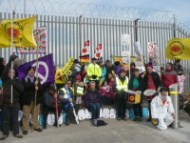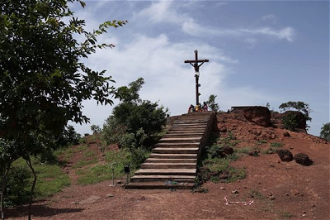Fukushima Vigil at Heysham Nuclear Power Station

More than 60 people, including members of Lancaster Diocese Faith and Justice Commission, held a vigil at Heysham Nuclear Power station on 8 March, the third anniversary of the nuclear accident at Fukishima in Japan. In part, they were inspired by Columban Sean McDonagh’s book, ‘Fukushima:The Death Knell for Nuclear Energy?’ which looked at the environmental concerns surrounding nuclear power, particularly learning lessons from what happened at Fukushima.
The gathering of concerned people - who met up first at Lancaster’s Quaker Meeting House - called upon EDF Energy to publicly answer a number of questions. In the face of climate change, rising sea levels and storm surges, these questions related to the safety of the reactors and the radioactive spent nuclear fuel which is temporarily stored on site at Heysham, prior to its transportation by rail to Sellafield. A further question asked related to the continuing and long-term problem of nuclear waste storage.
Local architect Mo Kelly measured levels during the recent winter storms affecting the Heysham area to demonstrate how high sea levels may be in 2100. Some held a long purple cloth showing where the seas on 3 January 2014 swept across the concrete promenade barely some seven metres from the flood defence wall to the power station. Using a measuring staff, Mo Kelly showed how high a five metre storm surge would be, making reference to the 18 metre storm surges seen on the Dorset coast this winter. The staff reached beyond the height of the security perimeter fence.
People stood in silence for some minutes after messages were read out, including from Japan, where the Fukushima nuclear meltdown occurred in 2011. Thousands of people who lived within 20 km of Fukushima have still not been able to return to their homes, and just weeks ago, on 20 February, another 100 tonnes of highly radioactive water leaked from the plant into the Pacific Ocean.
Mo Kelly handed in a letter to the operators of the power station, EDF, asking them to publicly list the specific details of the improved safety measures taken by the power station since Fukushima.
Gisela Renolds, a local resident from Lancaster, said: “People are concerned about how flooding will affect Heysham nuclear power station, and would like to know how they are preparing for climate change-induced sea level rises and storm surges. We want the operators of Heysham nuclear power station to tell us 1) How are they preparing for climate change-induced sea level rises and storm surges? 2) How we can we be sure that flooding will not cause nuclear waste leaks and 3) How can the nuclear power stations continue producing waste if there are no safe solutions for long-term storage?”
Others expressed concern about the problem of nuclear waste, which will remain highly radioactive for thousands of years. John Hammond from Silverdale said, “Back in the 1970s the nuclear industry said that they would develop the technologies to deal with nuclear waste, but in 2014 there is still no safe way to dispose of it.” Marianne Birkby of Radiation Free Lakeland said, “There is no long-term solution to nuclear waste though the industry is trying to force through a nuclear dump in Cumbria even though the Nirex Enquiry found it to be geologically unsafe.”
Since the vigil, Mo Kelly has been offered a meeting with Heysham’s Director. She says, “I'm taking up this offer and also raising the matter of evacuation (in the event of an accident causing a major release of radioactive particles) of the 188,000 population according to the 2001 census, of those towns located within 10 miles of Heysham, from Ulverston and Garstang in the north to Fleetwood in the south.”
In 1990, her professional body, the RIBA, produced a report entitled ‘Nuclear disasters and the built environment’ . This report specifically named two nuclear reactor sites which should never have been built, as they are too close to centres of populations. Mo Kelly points out that those sites are Heysham and Hartlepool, and a new reactor is proposed for Heysham, with a new fast road under construction, linking the M6 motorway with Heysham power station.
According to the Government, as many as 12 of Britain's 19 civil nuclear sites are at risk of flooding and coastal erosion because of climate change. According to The Guardian of 7 March 2012, the sites include all of the eight proposed for new nuclear power stations (including Heysham) around the coast, as well as numerous radioactive waste stores, operating reactors and defunct nuclear facilities.


















